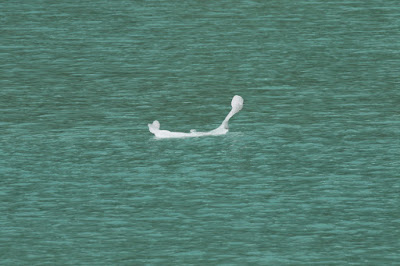Taking a break from
writing the Alaska Journal we headed to Bremerton, Washington. It was a short 1 1/2 hour drive from
Dungeness into a beautiful area of the Kitsap Peninsula.
We left in the
afternoon after work to take advantage of our next two days off. Our first stop was for Mark to play disc golf
at one of the many courses in the area.
This area averages 39
inches of rain a year. Both disc golf
courses Mark played were in beautiful, lush, green forests with towering
trees. On our 2 1/2 day trip Mark played
3 18-hole rounds on 2 different golf courses.
We had a couple of
other things planned besides disc golf!
The USS Turner Joy was
named after Admiral Charles Turner Joy (1895 - 1956), a veteran of World War II
and the Korean War. It was selected as a
Naval Memorial in 1988 and is now a permanent attraction on the Bremerton
waterfront.
USS Turner Joy
The Turner Joy was the
last Forrest Sherman Class destroyer built.
Of the 18 vessel class, only 2 remain.
As we boarded we were met by a wonderful volunteer who served on a
different destroyer (in the Forrest Sherman Class) during the Vietnam War. He was very interesting to talk with as he
had firsthand experience.
Mark talking to a volunteer.
With lots to see we
headed down.
With a crew of 332 there
wasn’t a lot of personal space. We went
through several berthing rooms. They did
not look very comfortable.
A tight fit!
The outer hull is only
3/8 of an inch thick. This makes the
ship lighter so it can go faster. It is
also the reason Destroyers are called Tin Cans.
Top speed 32.5 knots (37 1/2 mph).
3/8 inch thick.
Originally built with
3 5-inch Mark 42 guns and 4 3-inch Mark 33 guns, the 3-inch guns were removed
in 1970. The 3-inch guns had a limited effectiveness
and were too difficult to maintain.
5-inch gun.
Loading was entirely
automatic from an ammunition drum (containing 20 rounds) in the handling room,
up to the loading tray by means of a rotating hoist.
The weapons targeting
control center was the culmination of a series of US radar-equipped antiaircraft
systems developed during World War II.
The MK 56 became a dual-ballistic system, with the capability of issuing
simultaneous gun and fuse-setting orders to two different batteries of
different calibers, such as the 3-inch and 5-inch guns. It was extremely fast, producing a weapons
firing sequence with just two seconds of the time it began tracking an enemy
vessel.
Weapons Director
Control Room
Remember our wonderful volunteer that we met when we came on board? He found us again as we were touring the ship and told us that his job was in the Weapons Director Control room. (His first job when he came on board was to cook breakfast for the officers). He had some wonderful stories.
The Turner Joy was
commissioned in 1959. After several
tours in Pearl Harbor and Guam she was used for air-sea rescue duty near the
Mariana Islands for President Eisenhower.
Best remembered for her participation with USS Maddox in 1964 - an
action that led to the United States’ increased involvement in the Vietnam War.
This projectile
(bullet) weighs 70 pounds. The Sailors
would have to handle each of the 600 projectiles until they were all put away
in the magazine. They would have to do
that for all three of the 5-inch 54 caliber guns on the ship. Each gun had a crew of 14 men.
70 pound projectile.
This is a
second-generation, lightweight anti-submarine warfare (ASW) torpedo and the
first service torpedo with a seawater-activated battery as a power source.
Anti-submarine Warfare Torpedo
The torpedo launchers
utilized compressed air 1500 psi to catapult their torpedoes into the water.
Torpedo tubes.
The Combat Information
Center is often called the nerve center of the ship. It is responsible for collecting and
distributing operational information by using its radar, sonar, radio wave, and
other electronic search equipment. “Rigged
for red” means only the red lights are turned on. White lights are detectable from great
distances at sea.
Combat Information
Center (CIC)
The bridge is the main
control point for the entire ship. It is
the duty station of the captain and the officer on the deck. All orders and commands come from the bridge
while the ship is underway.
Mark on the Bridge
We saw many other
areas of the ship. I’m not sure if we
saw everything as there were lots of hallways and different levels, but we sure
made an effort to see it all.
Next time: The promised bug museum.
Teri


























































